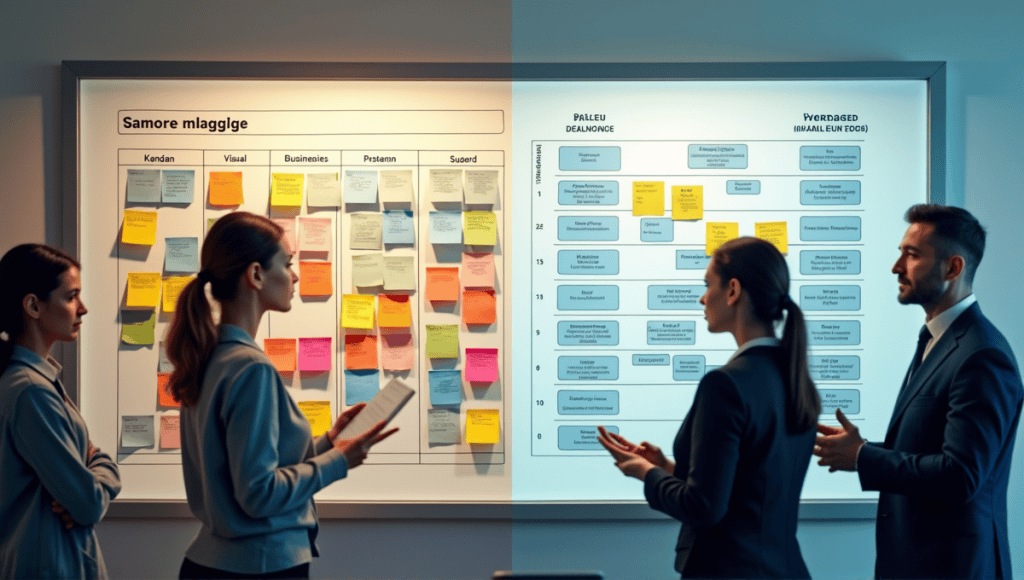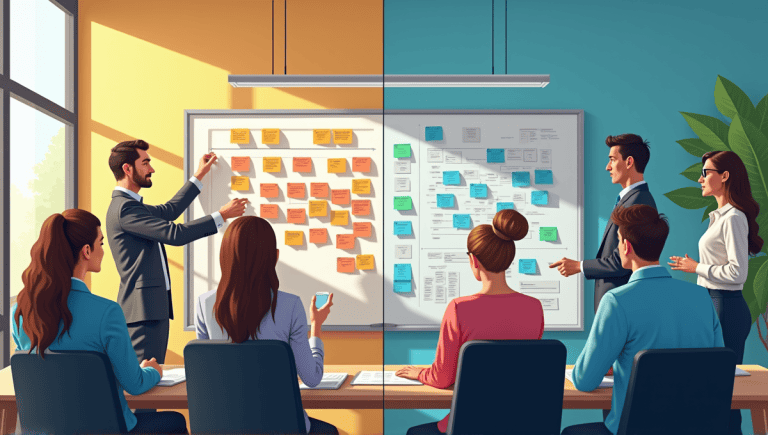Deciding whether to use Kanban or Waterfall is one of the most important decisions you’ll make about your project. I’ve watched teams succeed and fail using both approaches during my 15 years in software development. So let’s dispel the jargon and figure out which method is right for you. You’ll discover the main differences, the pros and cons of each methodology, and then you can confidently select the best methodology for your next project.
Kanban vs Waterfall: Key Characteristics

Kanban and Waterfall are two different project management methodologies. Kanban is all about continuous flow and visual management, using a board with columns for each stage of the workflow. Tasks move from one column to the next as they progress. This visual process makes it easy for teams to see any bottlenecks and improve the efficiency of the workflow.
Waterfall, on the other hand, is a sequential, linear process that breaks projects into distinct phases. Each phase must be finished before you can start the next one. Waterfall is very heavy on upfront planning and documentation.
At its core, Kanban is a visual workflow. You can see the status of any task at any given time, and this transparency naturally encourages collaboration and allows you to solve problems quickly. Waterfall’s greatest strength is its structured phases, which basically determine the project completion roadmap.
Kanban is designed for continuous flow. You always have team members working on multiple tasks at a time, constantly stopping and starting as priorities change. Waterfall, meanwhile, won’t let you start a new phase until the previous phase is done. This can be great for projects with fixed requirements.
Waterfall requires a lot of formal documentation including:
- Detailed project requirements
- Design specs
- Test plans
- User manuals
- Final project reports
Kanban, on the other hand, is more real-time communication and collaboration and less reliance on formal documentation.
Pros and Cons of Kanban and Waterfall
Kanban has several advantages:
- Flexibility to change priorities
- Better visibility into the workflow
- Less waste and higher efficiency
- Continuous delivery of value
However, Kanban is a little less structured than some projects require. It’s not ideal for projects with fixed deadlines or fixed scope. Waterfall has advantages:
- Clearly defined project structure and milestones
- Detailed documentation for future projects
- Easier to estimate costs and timelines
- Ideal for projects with fixed scope
However, Waterfall is too rigid. Once a phase is finished, it’s difficult to go back and change something. This can result in delays and additional costs if scope changes. Kanban is flexible and allows you to change things quickly. Teams can simply adjust the order of tasks if they learn something new. Waterfall is a linear path you can follow that’s predictable and very stable, but it sacrifices flexibility.
Comparing Two Project Management Approaches

Kanban visualizes work as continuous flow, with tasks moving across the board through various stages. Waterfall visualizes project work as sequential stages with distinct boundaries between each stage.
In Kanban, planning is ongoing and adaptive. You can change priorities to whatever is most important. In Waterfall, planning is comprehensive and done upfront.
In Kanban, team members often have fluid roles and collaborate on various tasks. In Waterfall, team members have specific roles and responsibilities within each project stage.
Ideal Use Cases for Kanban and Waterfall
Kanban is a good fit for:
- Software development and maintenance
- Support and service work
- R&D projects
- Marketing campaigns
Waterfall is an excellent choice for:
- Construction projects
- Manufacturing processes
- Regulatory compliance
- Projects with fixed requirements and a clear idea of what it looks like to be done
The context in which Kanban really shines is software development. Using Kanban, teams can make quick changes to address evolving user needs or market conditions. Many technology companies use Kanban to manage ongoing product development and improvements.
Waterfall is still widespread in industries like construction and manufacturing. These industries tend to have established processes and regulatory constraints. Waterfall’s structured approach is designed to ensure quality control and compliance.
Some companies use a combination of these methodologies or a hybrid strategy that borrows key components of both Kanban and Waterfall. This adaptability allows teams to take advantage of the benefits of each methodology. Agile scaling frameworks can help organizations implement these hybrid approaches effectively.
Implementation Requirements: Kanban vs Waterfall
Kanban requires no tools to get started. You can even use a physical board and sticky notes. Many teams use digital Kanban tools to collaborate more effectively. Most of these tools also connect with other project management tools.
Waterfall requires a significant amount of tooling. You’ll need robust project management software, as well as tools to build Gantt charts and create detailed project plans.
You’ll need to train Kanban teams on agile principles and visual management. You’ll also teach team members to focus on continuous improvement and responding to change. Waterfall requires teaching teams to become excellent at long-term planning and creating documentation.
In terms of documentation, waterfall produces a lot. You’ll write detailed requirements documents, project plans, and phase end reports. Kanban relies more on talking and less on writing, though, so it’s a bit less.
Changing from one to the other isn’t easy. Switching from waterfall to Kanban means people need to reset their minds. They’ll have to learn to become comfortable with change and improvement. Moving from Kanban to waterfall means people need to become comfortable with writing more documentation and focusing on upfront planning.
Team Size and Structure: Kanban vs Waterfall
Kanban is great for small or medium teams and is an excellent choice for teams of 5 to 15 people. The visual Kanban board, however, becomes difficult to manage as teams grow very large.
Waterfall is suitable for teams of various sizes and is commonly used in large projects with dozens or even hundreds of team members. The explicit framework makes it easy to manage large projects across multiple departments.
Kanban is flexible and you can make it work for a larger organization by connecting multiple Kanban boards. Doing so allows you to maintain agility while coordinating with the rest of the organization.
Waterfall is suitable for teams of various sizes and provides a clear framework with defined roles and responsibilities for each phase of the project, making it easy to manage large, multi-department projects.
Kanban encourages a cross-functional team of individuals with different skills working closely together. This structure fosters more effective problem solving and innovation.
Waterfall often separates teams by role for each project phase. This can create silos, but the upside is that you have a clear individual to hold accountable for each phase of the project.
Flexibility and Adaptation: Kanban vs Waterfall

Kanban is excellent at managing changes. Its visual nature enables teams to adjust the priority of tasks easily. New requirements can simply be added to the backlog and then worked into the process flow.
Waterfall offers a more formal change management approach. Changes often result in needing to revisit previous phases, and this can cause delays and increased costs. However, it also ensures that all changes are well thought out and documented.
Kanban is all about continuous improvement. Teams constantly evaluate processes and make small improvements. This results in a compounding effect of becoming more and more efficient and producing better results over time.
Waterfall is all about stability and predictability. Once requirements are set, the project plan does not change. This can be comforting to stakeholders who have a fixed timeline and fixed deliverables.
Kanban allows teams to immediately incorporate customer feedback. You can adjust priorities based on customer feedback immediately. In Waterfall, you typically only gather customer feedback at specific milestones in the project plan, and it can take longer to implement changes driven by customers.
Cost and Resource Implications
Kanban encourages more flexible resource allocation. People can easily switch between tasks as priorities change, maximizing skill usage more efficiently and reducing idle time.
Waterfall requires more detailed resource planning at the beginning. Each phase has specific resource requirements that must be planned in advance, making it easier to accurately budget at the beginning. resource allocation during execution.
In the long run, Kanban can be less expensive due to continuous improvement. Teams gradually become more efficient as they learn, equating to better resource utilization. Waterfall’s resource structure might be more predictable, but you might miss these ongoing efficiencies.
Kanban’s visual system also identifies resource bottlenecks more quickly. You can easily address them before they delay the project. Waterfall, on the other hand, might hide resource inefficiencies until later in the project.
Kanban offers ongoing, adaptive risk management. You can immediately mitigate emerging risks by adjusting priorities. Waterfall’s risk management is more systematic, with a formal risk assessment during each phase. This approach is more comprehensive, but less effective for addressing unexpected problems.
Both Kanban and Waterfall have their place in project management. The choice between them often depends on the nature of the project, team dynamics, and organizational culture. Some teams even use a hybrid approach, combining elements of both methodologies. For instance, they might use Kanban for ongoing maintenance work while employing Waterfall for large, structured projects. Agile project management techniques can help teams navigate these hybrid approaches effectively.
A Few Last Words
The decision to use Kanban vs Waterfall comes down to the specific needs of your project. Kanban is great if you value flexibility and the ability to constantly improve. Waterfall is ideal if you need structure and predictability. I’ve used both methodologies throughout my 15+ years of software development.
Think about your team size scalability needs, as well as the complexity of your project. Analyze the advantages and disadvantages of each methodology. Keep in mind that neither is a one size fits all solution. Choosing the right methodology will help you optimize your processes and increase productivity.






